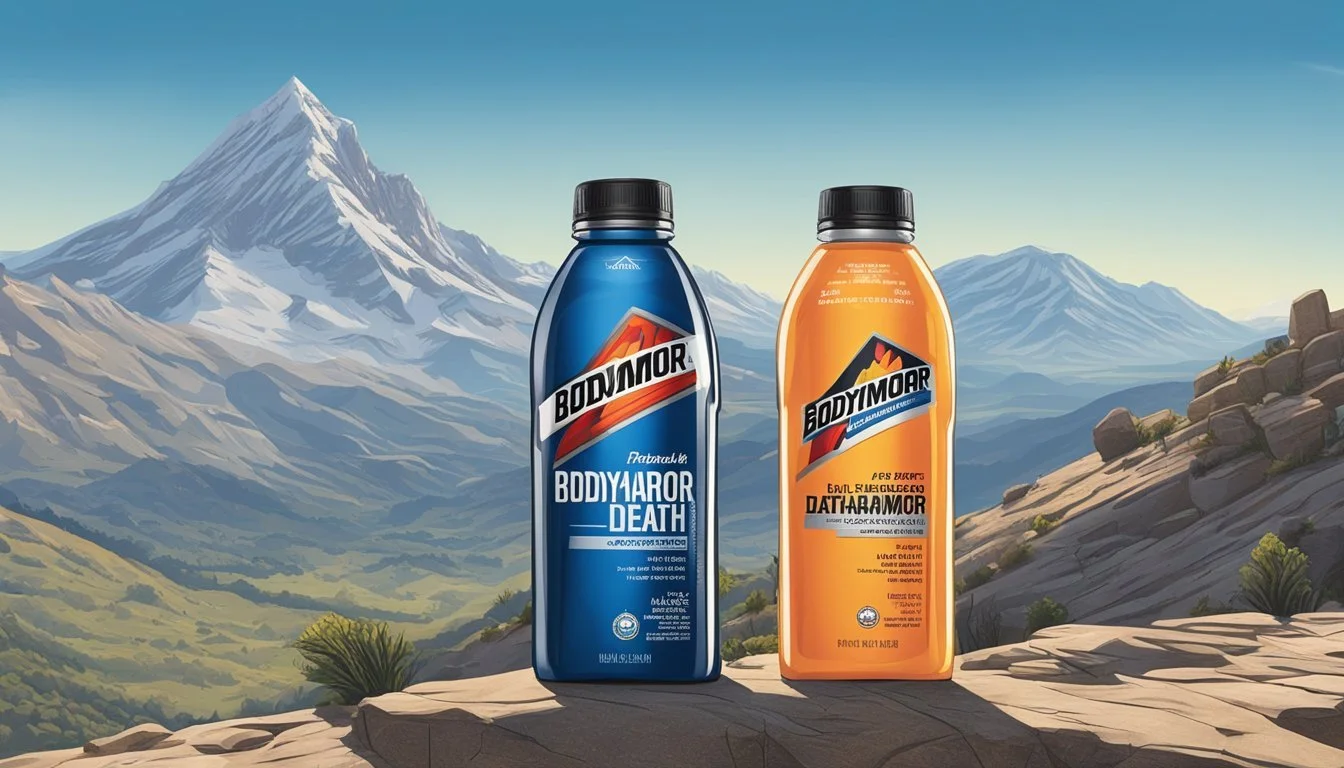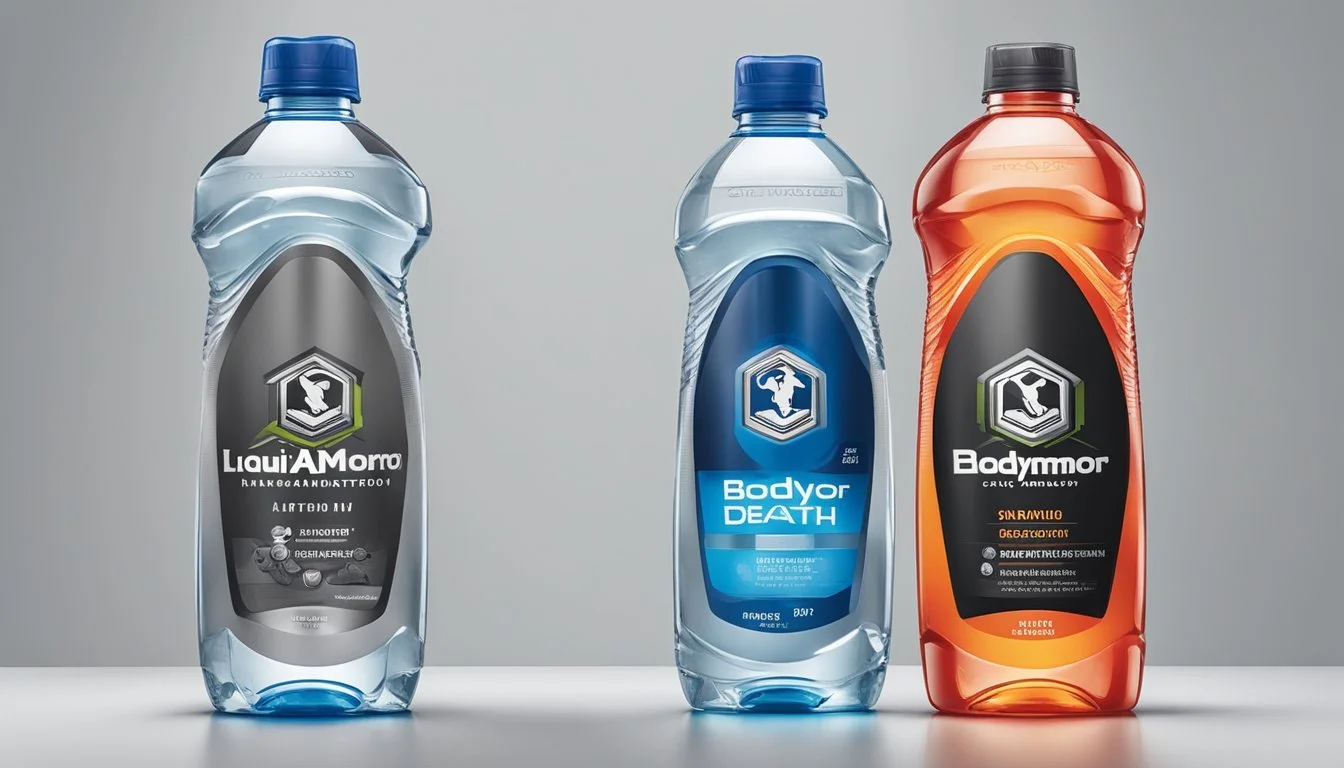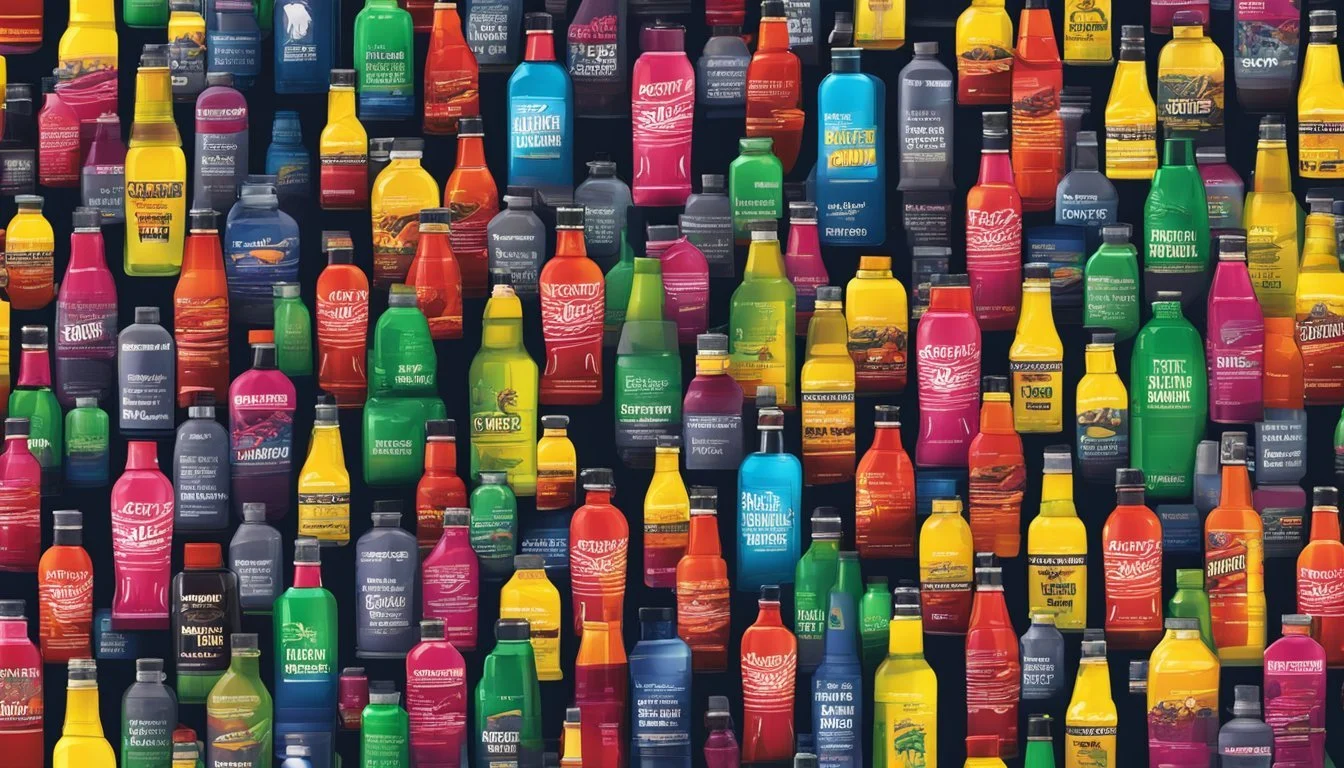Liquid Death vs. BodyArmor
Which Bottled Water Reigns Supreme?
Choosing between Liquid Death and BodyArmor bottled water can be a challenge for consumers seeking hydration. Liquid Death stands out for its unique branding and eco-friendly aluminum packaging, while BodyArmor offers enhanced hydration with added electrolytes and vitamins. This makes Liquid Death appealing for those who value sustainability, and BodyArmor a go-to for athletes and active individuals.
Liquid Death, available in both sparkling and still varieties, emphasizes purity with no additives, making it a healthier alternative to many plastic-bottled waters. BodyArmor, on the other hand, includes ingredients specifically designed to replenish and hydrate more efficiently, such as coconut water and essential vitamins.
Both brands cater to different needs, with Liquid Death focusing on environmental impact and simple hydration, and BodyArmor targeting performance and recovery. This distinction can help consumers align their choice with their personal health and environmental priorities.
Company Profiles
The following sections provide an in-depth look at the branding and mission of Liquid Death and the brand development and goals of BodyArmor. Each company has carved out a unique position in the competitive bottled water market.
Liquid Death: Branding and Mission
Liquid Death, founded by former Netflix creative director Mike Cessario, is known for its bold branding and irreverent marketing. The company’s slogan, "Murder Your Thirst," captures its edgy approach.
The brand uses a gothic aesthetic, featuring skulls and dark imagery reminiscent of craft beer. This distinct look appeals to a young, alternative audience.
Liquid Death also prioritizes sustainability. Their campaign, "Death to Plastic," emphasizes the use of aluminum cans to reduce plastic waste. They leverage social media platforms like Instagram and TikTok effectively, often featuring celebrities like Travis Barker to boost brand visibility.
BodyArmor: Brand Development and Goals
BodyArmor focuses on hydration and performance, targeting athletes and active individuals. Founded by Lance Collins and Mike Repole, the brand was swiftly recognized for its commitment to quality and innovation.
BodyArmor's marketing highlights its use of natural flavors and sweeteners, differentiating it from competitors. Their goal is to provide superior hydration, often positioning themselves against traditional sports drinks.
Partnerships with high-profile athletes enhance the brand’s credibility within the sports community. The company’s strategic objectives include expanding their product line and market share, particularly by reaching out to health-conscious consumers. Efficient use of bold, performance-oriented messaging has been key in its branding strategy.
Product Overview
In comparing Liquid Death and BodyArmor, it's important to note their distinct product ranges and packaging. Both brands offer unique options that cater to various consumer preferences.
Liquid Death Varieties
Liquid Death offers both sparkling and still water, sourced from the Austrian Alps. The water is finely filtered before being packaged in aluminum cans. This packaging choice is marketed as an eco-friendly alternative to plastic bottles, aiming to reduce plastic waste.
Notable products include their plain sparkling water and several flavored sparkling waters. Some popular flavors are Mango Chainsaw, a combination of mango and orange, lightly sweetened with agave. Consumers can purchase these waters individually or in multipacks from various retailers.
BodyArmor Offerings
BodyArmor focuses on flavored, nutrient-enhanced waters, positioning itself in the sports drink segment. Their water offerings include antioxidant-infused water and alkaline water with a higher pH level, which is marketed for better hydration and recovery.
They also offer BodyArmor SportWater, designed for athletes, featuring a proprietary electrolyte formula. Packaging typically consists of plastic bottles, ranging in sizes from 20 oz to 1-gallon options, catering to both casual drinkers and serious athletes. The brand emphasizes hydration and recovery benefits derived from added vitamins and minerals.
Health and Wellness Analysis
Liquid Death and BodyArmor both offer unique benefits when it comes to health and wellness. Key differences lie in their nutritional content and hydration capabilities, especially regarding vitamins and electrolytes.
Nutritional Content Comparison
Liquid Death provides two main products: Sparkling Water and Mountain Water. Both are free from added sugars, artificial flavors, and calories. They essentially offer pure hydration without any additional nutrients.
In contrast, BodyArmor includes added vitamins and minerals. These beverages often contain vitamin C, vitamin B, and essential minerals like potassium and magnesium. However, some BodyArmor drinks also contain added sugars to enhance taste, which may be a concern for those monitoring calorie and sugar intake.
Hydration and Electrolytes
Hydration is a critical factor for both products. Liquid Death focuses solely on hydration through pure water. This can be beneficial for maintaining balance without any risk of consuming excess sugars or artificial additives.
BodyArmor excels in hydration by including essential electrolytes like potassium and sodium. This makes it particularly effective for those engaging in intensive physical activity. Electrolytes play a crucial role in preventing dehydration and maintaining a proper pH balance.
Both options provide significant hydration, but the choice depends on individual health and wellness goals, such as the need for added nutrients versus a pure water option.
Environmental Impact
Liquid Death and BodyArmor differ significantly in their environmental footprints, primarily due to their packaging materials, approaches to recycling, and environmental initiatives.
Packaging Materials
Liquid Death uses aluminum cans for its water, which are widely recyclable and have a relatively lower carbon footprint compared to plastic. Aluminum cans are lightweight, reducing fuel consumption during transportation.
BodyArmor, on the other hand, predominantly uses plastic bottles. While plastic is lightweight and durable, it is often criticized for its long decomposition time and potential harm to the environment. Alternatives like glass are also considered, but they are heavier and more expensive to transport.
Recycling and Sustainability
Aluminum cans, such as those used by Liquid Death, have a high recycling rate. Aluminum can be recycled almost indefinitely without losing its quality, making it a sustainable choice. This reduces the need for raw materials and energy.
Plastic bottles, used by BodyArmor, have lower recycling rates and often end up in landfills or oceans. Recycling plastic usually involves downcycling, which results in lower quality over time. This makes plastic less sustainable compared to aluminum.
Brand Initiatives for Environment
Liquid Death has launched several campaigns under the slogan “Death to Plastic,” emphasizing the environmental benefits of aluminum cans. They invest in projects to remove plastic waste from oceans and rivers.
BodyArmor is also making strides in sustainability, focusing on reducing plastic usage and enhancing recycling efforts. They have initiatives to improve the recyclability of their plastic bottles and are exploring alternative materials to lessen their environmental impact.
By examining their packaging choices, recycling practices, and environmental initiatives, the differences between Liquid Death and BodyArmor become clear, highlighting the more eco-friendly features of aluminum cans versus plastic bottles.
Flavors and Ingredients
Liquid Death offers a variety of unique flavors and sparkling options. Some notable mentions include Convicted Melon, Mango Chainsaw, and Armless Palmer.
Convicted Melon consists of water flavored with natural ingredients and lightly sweetened with agave syrup. Mango Chainsaw combines mango and orange for a refreshing taste.
Flavor Ingredients Convicted Melon Natural flavors, agave syrup Mango Chainsaw Mango, orange, agave Armless Palmer Lemon, tea extracts Berry It Alive Berry flavors, agave syrup Black Cherry Black cherry flavor, agave syrup Cherry Obituary Cherry flavor, lemon juice concentrate
BodyArmor, known for its sports drinks, also has a selection of flavors such as Lemon, Cherry, and Lime.
The primary focus of BodyArmor's ingredients includes coconut water concentrate, electrolytes, and natural flavors. Unlike Liquid Death, BodyArmor avoids added sugars like agave syrup, instead using natural sweeteners.
Liquid Death emphasizes its eco-friendly aluminum cans and slightly alkaline water, promoting hydration. In contrast, BodyArmor's hydration solution relies on a blend of coconut water and added vitamins.
Both brands cater to different palates and preferences through their distinct flavor profiles and ingredient choices. Both offer unique options for those looking to stay hydrated and enjoy a refreshing beverage.
Consumer Experience
Consumers who purchase Liquid Death or BodyArmor often comment on the distinct taste, attractive packaging, and overall brand loyalty that each product promotes. Each offers a unique identity that caters to different preferences and experiences.
Taste Perception and Preferences
Liquid Death is praised for its crisp, refreshing taste. The brand ensures the water tastes pure by packaging it in aluminum cans, preventing any plastic taste, which often deters consumers.
BodyArmor, often recognized more for its flavored beverages, offers a sweeter and more varied taste experience. It contains added sugars and flavors, which appeals to those preferring a more dynamic beverage profile. While Liquid Death sticks to a more traditional water flavor, BodyArmor caters to those who enjoy a change from standard hydration options.
Packaging Design and Functionality
Liquid Death’s standout feature is its metallic can, emblazoned with a skull logo that appeals to a younger, more edgy demographic. The aluminum design not only contributes to the water's taste but also emphasizes sustainability, as the cans are easily recyclable. They are sturdy and convenient, minimizing the risk of leaks and breaks.Moreover, the branding of Liquid Death communicates a bold, anti-establishment ethos which many find compelling.
BodyArmor’s packaging is more conventional, with plastic bottles that might be less sustainable compared to Liquid Death's aluminum cans. However, it provides a transparent look at the beverage, which may appeal to those who prefer seeing the product they are consuming.
Brand Loyalty and Community
Liquid Death has developed a unique community feel, engaging consumers with its rebellious branding and messaging. It markets itself with a punk aesthetic, often using humor and irreverence to build a loyal following.
BodyArmor, with its focus on athletic performance and hydration, attracts a different kind of consumer loyalty, particularly among sports enthusiasts and health-conscious individuals. The brand leverages endorsements from athletes, adding credibility and fostering a dedicated customer base that values its functional hydration benefits.
Both brands have carved out distinct niches, driven by their unique approaches to taste, packaging, and branding.
Market Presence and Availability
Liquid Death and BodyArmor have distinct approaches to market presence and availability. Liquid Death focuses heavily on unique branding and alternative marketing techniques, while BodyArmor leverages its sports-oriented image to reach a different consumer base.
Retailer Analysis
Liquid Death is available in a variety of retail outlets, including Whole Foods, Target, and Publix. These stores ensure that the brand reaches a diverse consumer base. Liquid Death's aggressive marketing strategy has secured shelf space next to established brands like La Croix and Topo Chico.
BodyArmor is predominantly found in sports-oriented retailers and major supermarkets. They leverage partnerships with sports leagues and athletes to gain placement in stores frequented by fitness enthusiasts. Target and Walmart are among the key outlets where BodyArmor is prominently featured.
Online Sales Channels
Liquid Death has a strong online presence, capitalizing on platforms like Amazon and its own e-commerce website. This strategy has fueled rapid growth by appealing to a tech-savvy, young audience. Their branded online store offers subscription services and exclusive merchandise.
BodyArmor also utilizes Amazon for online sales, but their website focuses heavily on promoting new flavors and limited edition releases. The online market allows BodyArmor to reach consumers who prefer shopping from home or who follow fitness influencers promoting the brand.
Partnerships and Collaborations
Liquid Death excels in forging unconventional partnerships. They've collaborated with entities like Live Nation for concert and event promotions, embedding the brand in the lifestyle of their target demographic. These collaborations help enhance brand visibility in non-traditional spaces.
BodyArmor has strategically aligned with major sports leagues, including the NBA and MLB. These partnerships enable BodyArmor to position itself as a vital part of athletes’ hydration strategy. High-profile athlete endorsements from figures like Kobe Bryant (legacy) also amplify BodyArmor's market positioning.
Market Trend Insights
Liquid Death appeals to consumers drawn to its rebellious branding and eco-friendly packaging. The brand has tapped into the growing market for sustainable products by offering water in recyclable aluminum cans. This trend resonates with a younger, environmentally conscious audience.
BodyArmor aligns closely with the health and fitness trends dominating the beverage market. The demand for functional beverages that provide added benefits like vitamins and electrolytes has propelled BodyArmor’s market share. Their focus on sports hydration continues to cater to active lifestyles and health-conscious consumers.
Consumer Targeting and Marketing Strategies
Liquid Death and BodyArmor each utilize unique approaches to target their audiences. They leverage bold advertising, strong social media presence, and influential partnerships to capture consumer interest.
Advertising Campaigns
Liquid Death employs a rebellious and edgy branding strategy, positioning itself as an anti-establishment alternative in the bottled water market. Their campaigns often use dark humor and striking visuals that appeal to younger demographics, particularly Gen Z. The brand's motto, "murder your thirst," is an example of its unconventional approach.
BodyArmor, co-founded by Mike Repole, highlights its sports-hydration benefits, appealing to athletes and fitness enthusiasts. Their campaigns often feature professional athletes showcasing BodyArmor during intense workouts and sporting events, emphasizing performance and hydration.
Social Media Influence
Liquid Death has a robust presence on social media platforms like Instagram and TikTok. Their content often includes humorous and satirical videos that resonate with a younger audience. By engaging with trending topics and memes, Liquid Death has built a loyal online community. Founder Mike Cessario's background in creative advertising significantly contributes to the brand's innovative digital strategy.
BodyArmor leverages social media to connect with fitness communities and sports fans. Their posts frequently feature user-generated content from athletes and fitness influencers, creating a sense of authenticity and community. Engaging challenges and contests encourage followers to participate and share their experiences, broadening their reach.
Celebrity Endorsements and Partnerships
Liquid Death collaborates with celebrities and influencers to enhance its edgy image. One notable partnership is with Travis Barker, the drummer for Blink-182, who embodies the brand's rebellious spirit. These partnerships help Liquid Death appeal to a demographic seeking authenticity and rebellion.
BodyArmor partners with high-profile athletes such as Kobe Bryant and Megan Rapinoe, leveraging their credibility and fan base. These endorsements reinforce BodyArmor's commitment to performance and wellness. The brand's association with successful athletes builds trust and attracts consumers who prioritize fitness and health.
In conclusion, both brands employ distinct strategies to target their respective audiences. Liquid Death's irreverent marketing contrasts with BodyArmor's sports-centric approach, each finding success within their niches.
Lifestyle and Use Cases
When it comes to choosing between Liquid Death and BodyArmor, lifestyle and specific use cases play important roles. Whether you are an athlete or someone who needs hydration on the go, understanding the nuances of each product can help make a more informed decision.
Athletic and Fitness Compatibility
For athletes, hydration is crucial. BodyArmor offers electrolyte-rich still water, which can be highly beneficial for post-workout recovery. Its ingredients include potassium and vitamins that support rehydration and nutrient replenishment. This makes it a suitable option for those who engage in high-intensity workouts or sports.
Liquid Death, on the other hand, provides both still and sparkling water options. The sparkling water, with its refreshing carbonation, can be a good choice for a quick refreshment post-exercise. However, it lacks the added electrolytes found in BodyArmor, making it less specialized for athletic recovery but still effective for basic hydration needs.
Convenience for On-the-Go Consumption
In terms of convenience for on-the-go consumption, Liquid Death excels due to its packaging. The water is available in aluminum cans, which are easy to carry around and are resealable. They are particularly useful for car trips, outdoor activities, and even social settings like bars where people may want a non-alcoholic beverage option.
BodyArmor also provides portable options, typically in plastic bottles which can be more lightweight. These bottles are easy to stash in gym bags, making them convenient for those who need a quick hydration fix during or after physical activities. However, for social environments, Liquid Death's canned water might be more aesthetically pleasing and practical.
More About Liquid Death
Aqua Carpatica vs Liquid Death: Which Bottled Water is Better?
Core Hydration vs Liquid Death: Which Bottled Water is Better?
Hawaii Volcanic vs Liquid Death: Which Bottled Water is Better?
Hawaiian Springs vs Liquid Death: Which Bottled Water is Better?
Ice Mountain vs Liquid Death: Which Bottled Water is Better?
Icelandic Glacial vs Liquid Death: Which Bottled Water is Better?
Liquid Death vs Cascade Mountain: Which Bottled Water is Better?
Liquid Death vs Crystal Geyser: Which Bottled Water is Better?
Liquid Death vs Crystal Lake: Which Bottled Water is Better?
Liquid Death vs Essence pH10: Which Bottled Water is Better?
Liquid Death vs Kirkland Signature: Which Bottled Water is Better?
Liquid Death vs Proud Source: Which Bottled Water is Better?
Liquid Death vs Richard's Rainwater: Which Bottled Water is Better?
Liquid Death vs Simple Truth: Which Bottled Water is Better?
Liquid Death vs Talking Rain AQA: Which Bottled Water is Better?
Liquid Death vs Whole Foods 365: Which Bottled Water is Better?
Liquid Death vs Whole Foods Italian Still Mineral water: Which Bottled Water is Better?
Mountain Valley Spring Water vs Liquid Death: Which Bottled Water is Better?
Nestle Pure Life vs Liquid Death: Which Bottled Water is Better?
Poland Spring vs Liquid Death: Which Bottled Water is Better?
Purely Sedona vs Liquid Death: Which Bottled Water is Better?
San Pellegrino vs Liquid Death: Which Bottled Water is Better?
Solan de Cabras vs Liquid Death: Which Bottled Water is Better?
More About BodyArmor
BodyArmor vs Kirkland Signature: Which Bottled Water is Better?
Cascade Mountain vs BodyArmor: Which Bottled Water is Better?
Hawaii Volcanic vs BodyArmor: Which Bottled Water is Better?
Hawaiian Springs vs BodyArmor: Which Bottled Water is Better?
Icelandic Glacial vs BodyArmor: Which Bottled Water is Better?
Mountain Valley Spring Water vs BodyArmor: Which Bottled Water is Better?
Nestle Pure Life vs BodyArmor: Which Bottled Water is Better?
Richard's Rainwater vs BodyArmor: Which Bottled Water is Better?
Solan de Cabras vs BodyArmor: Which Bottled Water is Better?
Talking Rain AQA vs BodyArmor: Which Bottled Water is Better?
Whole Foods 365 vs BodyArmor: Which Bottled Water is Better?
Whole Foods Italian Still Mineral water vs BodyArmor: Which Bottled Water is Better?








